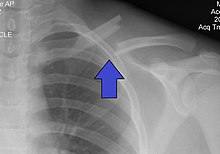| Clavicle fracture | |
|---|---|
| Other names | Broken collarbone[1] |
 | |
| X-ray of a left clavicle fracture | |
| Specialty | Emergency medicine |
| Symptoms | Pain, decreased ability to move the affected arm[1] |
| Complications | Pneumothorax, injury to the nerves or blood vessels in the area, unpleasant appearance[2] |
| Usual onset | Sudden[3] |
| Types | Type I (middle 3rd), Type II (lateral 3rd), Type III (medial third)[3] |
| Causes | Fall onto a shoulder, outstretched arm, or direct trauma[1][3] |
| Diagnostic method | Based on symptoms, confirmed with X-rays[2] |
| Treatment | Pain medication, sling (1-3 wks), surgery[1][2] |
| Prognosis | Up to five months for complete healing[3] |
| Frequency | 5% of adult fractures, 13% of children's fractures[1][3] |
A clavicle fracture, also known as a broken collarbone, is a bone fracture of the clavicle.[1] Symptoms typically include pain at the site of the break and a decreased ability to move the affected arm.[1] Complications can include a collection of air in the pleural space surrounding the lung (pneumothorax), injury to the nerves or blood vessels in the area, and an unpleasant appearance.[2]
It is often caused by a fall onto a shoulder, outstretched arm, or direct trauma.[1][3] The fracture can also occur in a baby during childbirth.[1] The middle section of the clavicle is most often involved.[3] Diagnosis is typically based on symptoms and confirmed with X-rays.[2]
They are typically treated by putting the arm in a sling for one or three weeks.[1][2][4] Pain medication such as paracetamol (acetaminophen) may be useful.[1] It can take up to five months for the strength of the bone to return to normal.[3] Reasons for surgical repair include an open fracture, involvement of the nerves or blood vessels, or shortening of the clavicle by more than 1.5 cm in a young person.[1][5]
Clavicle fractures most commonly occur in people under the age of 25 and those over the age of 70.[2][3] Among the younger group males are more often affected than females.[3] In adults they make up about 5% of all fractures while in children they represent about 13% of fractures.[1][3]
References
edit- ^ a b c d e f g h i j k l m "Clavicle Fracture (Broken Collarbone)-OrthoInfo - AAOS". orthoinfo.aaos.org. Dec 2016. Archived from the original on 4 September 2017. Retrieved 26 September 2017.
- ^ a b c d e f g Pecci M, Kreher JB (January 2008). "Clavicle fractures". American Family Physician. 77 (1): 65–70. PMID 18236824.
- ^ a b c d e f g h i j k Paladini P, Pellegrini A, Merolla G, Campi F, Porcellini G (January 2012). "Treatment of clavicle fractures". Translational Medicine @ UniSa. 2: 47–58. PMC 3728778. PMID 23905044.
- ^ "Kids Health Information : Fracture care: clavicle (collar bone)". www.rch.org.au. Archived from the original on 2023-01-21. Retrieved 2023-02-08.
- ^ Ropars M, Thomazeau H, Huten D (February 2017). "Clavicle fractures". Orthopaedics & Traumatology, Surgery & Research. 103 (1S): S53–S59. doi:10.1016/j.otsr.2016.11.007. PMID 28043849.